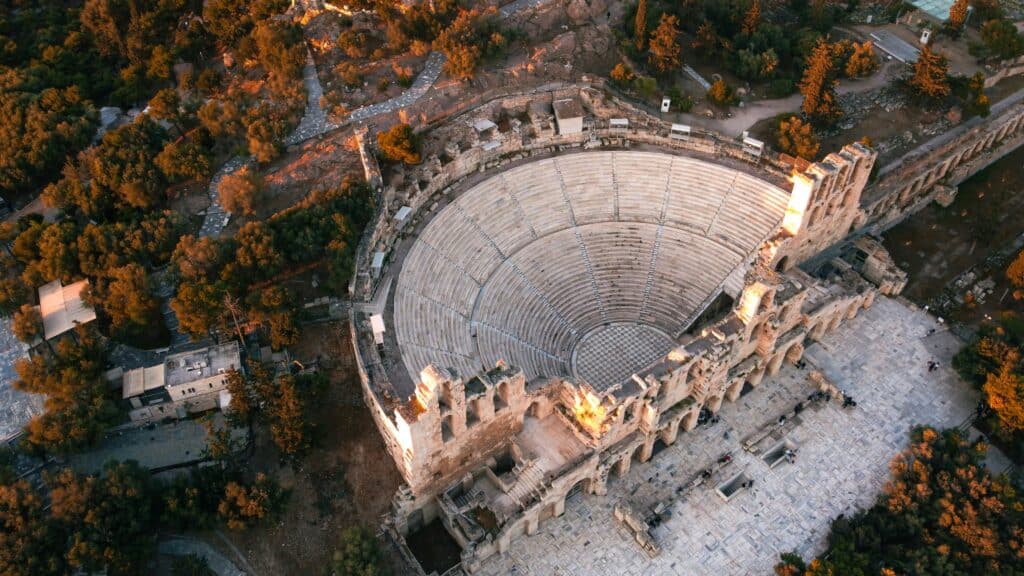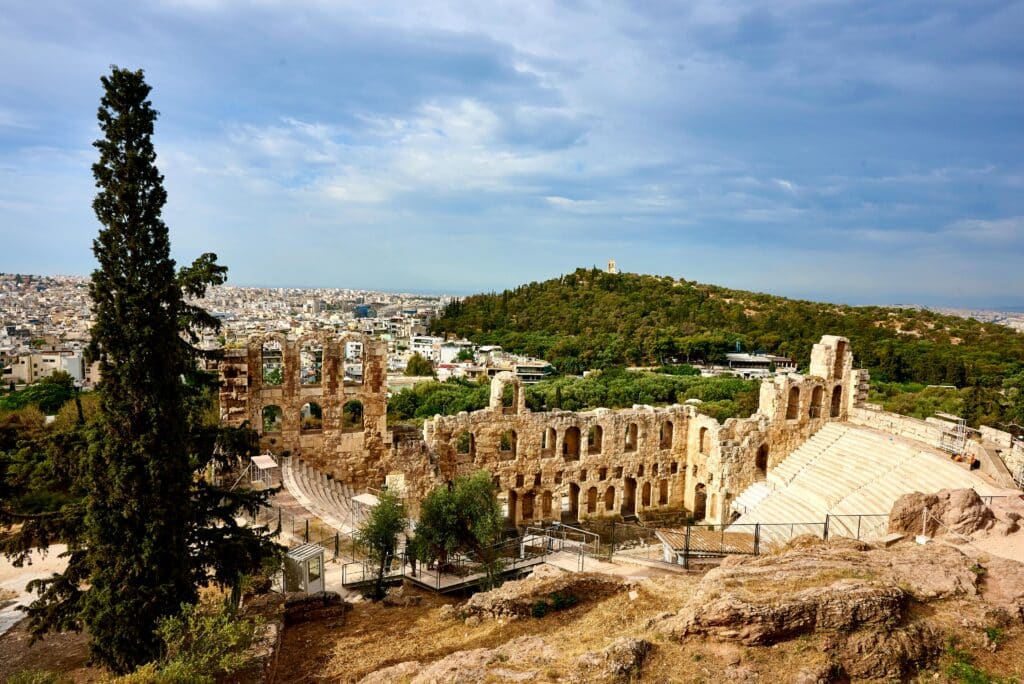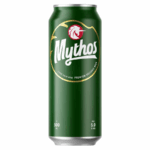The Odeon of Herod Atticus, a Majestic Monument of Roman Antiquity
The Odeon of Herod Atticus, located at the foot of the Acropolis in Athens, is an emblematic monument of Roman Antiquity. Built in the 2ᵉ century by Herod Atticus, it is a masterly example of Roman architecture. Dedicated to entertainment, the theater played a key role in the cultural and social life of Athens. It hosted musical, theatrical and political events, making it an important center of the ancient city.
It served as a gathering place for Athenians and visitors from all over the Roman Empire. It reflected the grandeur of the city, fusing culture and politics. Even today, the Odeon is used for events, continuing to bear witness to Athens’ cultural heritage.
The Fascinating Story of Herod Atticus' Odeon
The historical context and reasons for its construction
The Odeon of Herod Atticus was built between 161 and 174 A.D., at a time when Athens, although still an important cultural center, was recovering from the destruction inflicted by the Romans several centuries earlier. The Roman Empire was expanding rapidly, and Herod Atticus, a wealthy Greek aristocrat and patron of the arts, wanted to give his native city back a large-scale venue for public performances and events. For him, it was also a question of establishing his prestige while honoring his Greek roots and contributing to the greatness of Athens.
This project was part of a series of patronage initiatives undertaken by Herod Atticus to improve the city. He had already financed the reconstruction of several public buildings and the restoration of aqueducts. The Odeon, designed for musical and theatrical performances, was intended not only to strengthen Athenian culture, but also to mark the imperial era and Herod Atticus’ personal commitment.
Herod Atticus and his influence on the project
Herod Atticus was a leading figure of his time. Born in 101 into a wealthy family of Roman descent, he was educated in Rome before returning to Athens, where he decided to play a major role in the city’s development. His status as a member of the Roman imperial elite, and his great wealth, enabled him to finance major charitable and patronage projects. The Odeon of Herod Atticus is one of the greatest examples of his influence.
It is interesting to note that Herod Atticus financed the construction of this monument to mark his love for his native city and strengthen the cultural ties between Greece and Rome. His patronage was intended to reinforce his image as a benefactor and leave a lasting imprint on the history of Athens. By commissioning such an imposing edifice, Herod Atticus also wanted to rival the great Roman families and mark his passage through history.
The stages in its construction and the challenges encountered
Building the Odeon required considerable technical effort. The theater, which could seat up to 5,000 spectators, was designed in the Roman style while respecting Greek aesthetics. The Odeon was not only a performance space, but also a place of perfect acoustics. The major challenge for the architects was to design a building that was both imposing and functional, with acoustics as precise as today’s, so that every spectator could hear the performances without modern amplification.
The building’s architecture combined elements of classical Greek architecture with Roman innovations. The roof, initially made of wood, was destroyed by fire. Subsequently, earthquakes shook the monument on several occasions. However, the Odeon’s structure remained solid. It bears witness to the ingenuity of the architects of the time. In the face of natural disasters and external attacks, the Odeon has shown great resilience.
Recent excavations have also revealed elements of the building’s original decoration, including sculptures and mosaics that were destroyed over time. This shows that, although the Odeon has suffered much destruction, it has stood the test of time as a symbol of the legacy of the Roman Empire in Greece.
The Odeon of Herod Atticus: A Model of Ancient Architectural Ingenuity
Detailed description of the Odeon's architecture
The Odeon of Herod Atticus is distinguished by its imposing architecture and refined details. Built of stone, the building measures around 70 meters wide and 20 meters high. The Odeon has a semicircular structure inspired by Greek theaters, but with Roman additions. The amphitheatre is perfectly integrated into the natural slope of the hill, affording a breathtaking view of the surrounding landscape. This strategic detail underlines the harmony between the building and its natural surroundings, offering both exceptional acoustics and majestic aesthetics.
The building’s unique acoustics are one of its most outstanding features. The Odeon was designed to guarantee perfect sound. The building materials, the semi-circular shape of the amphitheatre, and the arrangement of its rows of seats all contribute to amplifying the speakers’ voices, ensuring that every spectator can hear the performance, wherever they happen to be. This innovation in acoustic design demonstrates the ingenuity of Roman architects of the time.
The influence of Greek and Roman architecture
The architecture of the Odeon reflects a perfect fusion of Greek and Roman influences. The building’s style is based on classical Greek architecture, while incorporating Roman elements such as the use of stone and arched structures. The Doric style of columns, typical of Greek architecture, is present in the building’s façade. However, the Romans added their own touch, enhancing the functional aspect of the venue, with technical improvements to improve acoustics and seating capacity.
The Romans also introduced a much stronger structure, capable of supporting grandiose musical performances, with a seating configuration that could accommodate up to 5,000 spectators. The Roman modifications were aimed at reinforcing the theatrical aspect of the venue while adding decorative elements. This combination of Greek style and Roman innovation made the Odeon a model of architecture for centuries to come.
Comparison with other ancient Roman buildings
The Odeon of Herod Atticus shares similarities with other emblematic buildings of the Roman Empire. For example, it is often compared to the Colosseum in Rome. However, unlike the Colosseum, dedicated to gladiatorial combat, the Odeon was a place devoted to the arts, notably music and poetry. It is also reminiscent of other Roman theaters, such as the one in Pompeii, designed to optimize acoustics and visibility.
The smaller size of the Odeon of Herod Atticus compared to the Colosseum or the theater of Pompeii in no way diminishes its grandeur. On the contrary, its intimacy and perfect acoustics make it a place where every spectator can enjoy performances with unrivalled clarity. These features make the Odeon of Herod Atticus an outstanding example of Roman architecture, combining grandeur, technical innovation and aesthetic beauty.
The Odeon in Antiquity: A Cultural and Political Center of Athens
Herod Atticus’ Odeon was more than just a performance venue. It also served as a major cultural and political center in Athens.
First, it hosted concerts, plays and political events. As a theater, it was used for performances of dramatic plays, often Greek tragedies. These performances, rich in emotion and meaning, were essential to Athenian society. The Odeon served as a stage for numerous festivals, notably the Great Dionysias, in honor of Dionysus, the god of wine and fertility.
What’s more, it provided a space for political gatherings. The theater was not only a place of entertainment, but also a means for the citizens of Athens to gather and debate issues of importance to the city. It therefore played a key role in the functioning of Athenian democracy.
The Odeon was a multi-purpose venue that reinforced the culture and politics of the time. It reconciled art and public management, contributing to Athens’ influence in the Roman Empire and beyond.
Preserving the Odeon: Between Restoration and Modern Challenges
The first restoration efforts
The Odeon of Herod Atticus has stood the test of time, and several restorations have been carried out to preserve this emblematic monument. As early as the late 19th and early 20th centuries, work was carried out to stabilize structures damaged by time and war. In the 1950s, for example, the Greek government launched a vast restoration operation. This initiative enabled the tiers and columns to be put back in place, while preserving the monument’s authenticity.
Modern conservation techniques
Modern conservation work continues to this day. The aim is to maintain the integrity of the Odeon while making it accessible to visitors from all over the world. These efforts are made necessary by the progressive wear and tear of the materials. Humidity, climatic changes and storms, which are frequent in the region, are slowly degrading the stones and sculptures. Specialists use advanced techniques, such as injecting special resins into the walls and protecting the sculptures from the elements.
The challenge of tourism
Another major challenge to preserving the Odeon is the impact of tourism. Every year, millions of visitors come to admire this monument. If not properly managed, this influx of visitors can accelerate wear and tear on the building. The Greek authorities have introduced strict measures to limit the number of visitors in certain areas. For example, access to certain areas is restricted during peak periods. In addition, qualified guides and information panels make visitors aware of good practices, thus reducing the risk of damage.
Ensuring long-term preservation
The combined efforts of restoration and tourism management ensure the long-term preservation of this architectural masterpiece. It remains a living testimony to the ingenuity and grandeur of ancient times, as well as being an important symbol of modern Greece.
The Odeon of Herod Atticus Today: A Cultural and Tourist Site
A modern venue for shows and festivals
Today, the Odeon of Herod Atticus continues to play a central role in Athens’ cultural scene. It hosts prestigious events, including concerts, theatrical performances and international festivals. The most famous is the Festival of Athens and Epidaurus, held every summer. This festival attracts artists and spectators from all over the world to attend classical and modern productions in the Odéon’s exceptional acoustics. In this way, the Odeon is no longer just a witness to the past, but a living player in contemporary culture.
Tourism and its impact on conservation
The Odeon is also one of Athens’ most visited tourist sites. Every year, thousands of tourists come to discover this emblematic monument, contributing to the local economy. However, this influx poses a challenge for its conservation. The Greek authorities have put in place measures to manage visitor numbers and limit the risk of damage. The site is carefully monitored to preserve its integrity, while allowing tourists to enjoy an immersive experience that respects the monument.
A cultural destination not to be missed
The Odeon of Herod Atticus continues to fascinate with its history, its architecture and its role in modern cultural events. It embodies the heritage of ancient Greece, yet is also part of today’s cultural life. Thanks to a combination of preservation and modern use, the Odeon remains a must-see site for history and culture enthusiasts.
Interesting facts and anecdotes
Exceptional acoustics
The Odeon of Herod Atticus is renowned for its remarkable acoustics. Its semicircular shape and the materials used in its construction, notably marble, ensure perfect sound transmission. Performances given in this building benefit from natural acoustics that allow even the weakest voices to resonate clearly throughout the theater. This is one of the secrets that makes the Odeon an ideal venue for modern concerts and theatrical performances.
Fascinating rumors and legends
There are many legends surrounding the Odeon. One says that the building was designed with such precision that artists performing inside could hear their own voices particularly amplified, enhancing the performance experience. Others claim that the stones of the Odeon possessed mystical powers, notably to soothe the sick. These rumors, though unverifiable, add a special charm to the building.
Impressive construction
Building the Odeon was no simple project. Herod Atticus faced many challenges, including the difficult terrain of Athens and the need to preserve the integrity of ancient structures. The Odeon was an example of ingenuity and architectural precision, enabling the building not only to be functional, but also to become a masterpiece of Roman antiquity.
The first concert in 1950
The first official concert given in the Odeon of Herod Atticus after its restoration in 1950 was a performance by the National Symphony Orchestra of Athens, marking the beginning of a new era for this ancient building. Since then, the Odeon has been the stage for many prestigious performances, welcoming artists from all over the world. The reopening symbolized the cultural resurrection of the building.
Curiosities and Secrets of Ancient Architecture
Beyond its architectural beauty, the Parthenon is full of intriguing stories and little-known facts. Here are some fascinating facts to discover:
The mysterious "optics" of the Parthenon columns
The optics refer to the subtle curves of the columns and stylobate. They are not straight, but slightly curved to correct the optical distortions caused by perspective. This ingenious technique demonstrates the mastery of ancient Greek architecture.
The number of sculptures still on the site
Today, some of the original sculptures remain on the site, such as the friezes and pediments. Lord Elgin removed many of these sculptures in the early 19th century. Others are preserved in museums, notably the British Museum.
Recent discoveries in the Parthenon excavations
Archaeological excavations continue to reveal new elements, such as fragments of statues and inscriptions, which help us to better understand the structure and function of the Parthenon in antiquity.
The first excavation of the Parthenon
One of the first to seriously excavate the site was Greek archaeologist Kyriakos Pittakis in the early 19th century. He uncovered several important elements and contributed to the preservation of the Parthenon at a time when the building was in poor condition. Interest in the Parthenon then grew considerably in the 19th century, with international interest in Greek archaeology.
The Parthenon as Christian temple and mosque
The Parthenon, dedicated to the goddess Athena, became a Christian church in the 6th century. Later, after the Ottoman conquest in the 15th century, it was transformed into a mosque. This transformation modified the Parthenon, adding minarets and Christian iconographic elements. It also suffered considerable damage from battles and attacks.
The role of marble in Western art
The sculptures of the Parthenon have had a profound influence on Western art. After their extraction by Lord Elgin, the marbles were exhibited in London. They became a benchmark for 19th-century artists. The marbles inspired many artists, including Renaissance sculptors and those of the neoclassical movement.
The temple used as an arsenal
During the Greek War of Independence against the Ottoman Empire, the Ottomans used the Parthenon as a military arsenal. In 1687, a Venetian bombardment hit the Parthenon while it was being used as a gunpowder depot. This caused a massive explosion, destroying part of the structure.
The Parthenon friezes and their aesthetic influence
The Parthenon frieze is a sculptural masterpiece. In addition to its beauty, it is a testament to the technical and artistic skills of ancient Greek sculptors. The friezes depict a religious procession, representing the greatness and dignity of the Athenian people. These friezes have profoundly influenced the visual arts in the history of art.
The Odeon of Herod Atticus and its Contribution to Music and Theatre
The Odeon of Herod Atticus, built in the 2nd century AD, is not only a historic monument, but also a key venue for music and theater. Its unique design, including exceptional acoustics, made it an ideal site for ancient performances. The theater was primarily used for concerts and dramatic performances, hosting open-air performances where sound quality was paramount. This enabled actors and musicians to perform in front of thousands of spectators without modern sound systems, proving the ingenuity of the ancient Greek architects.
Influence on Antique Performance
In ancient times, the Odeon of Herod Atticus was famous for its exceptional acoustic characteristics. The auditorium’s marble structure, arches and semi-circular layout ensured natural resonance. This ensured that the actors’ voices and the music reached everyone in the audience, even those at the back. The acoustic conditions were perfect for the performance of classical Greek tragedies and comedies. Plays by Aeschylus, Sophocles and Euripides were performed here, contributing to the development of Greek theater.
L'Odéon Today: A Privileged Venue for Modern Music and Theatre
Today, the Odeon of Herod Atticus continues to be a lively site for artistic performances. Although modern sound technology has evolved, the theater’s natural acoustics remain a major asset for artists. Classical music concerts, operas and theater festivals regularly take place in this iconic venue, attracting artists and spectators from all over the world. Renowned performances, such as those at the Athens Festival, take place every year, where contemporary musicians and directors are fascinated by the resonance of the venue and the historic atmosphere it exudes.
Impact on Modern Artists
The Odeon’s impact also extends to the way modern artists approach the stage. Contemporary performances are often inspired by the configuration of the ancient theater, not only in terms of sound, but also the immersive experience it offers the audience. Directors and composers particularly appreciate the intimacy that exists between stage and audience, a phenomenon that has disappeared in many modern theaters. This shows that the Odeon, while a relic of the past, remains a center of artistic innovation and a model for the integration of music and theater in a historic space.
Practical tips for visiting the Odeon of Herod Atticus
Timetables and tickets
The Odeon of Herod Atticus remains open all year round, but opening times vary according to the season. Visitors can buy tickets at the entrance or online. It is advisable to book in advance for quicker access, especially during the high tourist season.
Best times to visit
Early morning is the best time to avoid the crowds. You can also plan your visit during the Athens Festival, the country’s major cultural event. In summer, the Odeon hosts concerts and shows of international renown, offering a unique experience.
Tips for a pleasant visit
Wear comfortable shoes, as the Odeon is located on a hill, and the paths can be slippery. Bring water, especially in summer, when temperatures can reach high levels. Also, check if there’s a special event so you can adapt your visit accordingly.
Accessibility
Wear comfortable shoes, as the Odeon is on a hill with slippery paths. Bring water, especially in summer, as the heat can be intense. Also check scheduled events to adapt your visit accordingly.
















